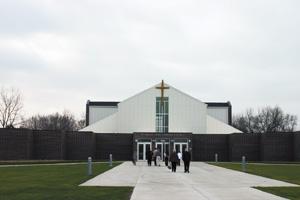
By Celine Klosterman
CORALVILLE — In its mission statement, St. Thomas More Parish says it strives to be a parish for all seasons.
On Nov. 14 it embraced a new season, dedicating what parishioners described as a beautiful, simple church in a new town. More than 500 people attended the first Mass at the building in Coralville, capping decades of parish history in Iowa City.
“Today a new chapter in that history is written as we dedicate this church as a place of gathering and prayer,” Bishop Martin Amos, the Mass’ celebrant, said in his homily.
Constructing that church took much effort from many people, he acknowledged, but so does building the “spiritual temple” of which St. Paul speaks in his letter to the Ephesians. “No matter how beautiful a building might look, if it does not have a strong foundation, it will not last,” Bishop Amos said.
Our foundation is the apostles and prophets; Jesus is the capstone, he said. Parishioners must pass on the faith passed down to them from the apostles and from priests, deacons, religious and catechists who served at St. Thomas More, the bishop continued.
Building on the apostles’ and prophets’ foundation requires reading, proclaiming and hearing the Scripture and praying.
“It is in this structure that prayers and petitions will ascend to the throne of grace when you come privately to pray, celebrate devotions and certainly as you celebrate the Liturgy of the Hours and Liturgy of the Eucharist,” Bishop Amos said.
“It is in this structure that you will hear such things as the words that bring life: ‘I baptize you’; words of healing: ‘I absolve you’; and words of lifelong commitment: ‘I do.’” Hopefully, a newly ordained priest from the parish would say the words of his first Mass in the church, too, the bishop said.
“Today’s celebration is not so much about this building as it is about the mystery of the church in which we form the building.”
Bishop Amos highlighted the community of Catholics, all of whom he said are “living stones” in that building. People will enter their community through the waters of baptism in St. Thomas More Church, he noted.
After his homily, the church’s altar and walls were anointed; incense was burned; candles were lit and the Blessed Sacrament chapel was inaugurated.
Such rites were followed in the consecration of a building that parish leaders noted was the work of many people. John LePeau, steering committee chair, acknowledged contributors including Father Walter Helms, pastor, at the beginning of Mass. “In the best tradition of St. Thomas More Parish, you provided necessary guidance while allowing and encouraging the laity to exercise their legitimate roles of leadership,” LePeau told the priest. LePeau also thanked parish staff for providing stability during the parish’s transition, and recognized numerous other individuals and groups.
In turn, Fr. Helms thanked LePeau, who received a standing ovation. “We are extremely grateful for the grace of John’s meticulous attention to detail and infinite patience in guiding us through the many steps of this first phase of our building project,” the pastor said.
He also acknowledged Kathy Donnelly, art and environment committee chair; Jim and Mary Merchant, general chairs of the capital campaign; and Judy Duncan, who offered musical and liturgical leadership for the dedication Mass.
“I didn’t want to miss this,” parishioner Jane Bragg said of the celebration. She spoke of the church’s beauty and simplicity, and said she favored the relocation in part because she thought St. Thomas More was liberal enough to adjust to the move.
Parishioner Dale Helling said the relocation may foster parish unity because parishioners are now more likely to live in the same neighborhoods — in contrast to when the church stood within blocks of three other parishes in Iowa City.
Spreading the parishes throughout the Iowa City and Coralville area will better serve Catholics, said Jim Bradbury, steering committee member. Now preparing to relocate is St. Patrick Parish in downtown Iowa City, which will move to the city’s east side.
“I think it couldn’t be any prettier,” parishioner Marcia Cleveland said of St. Thomas More Church. She suggested the building’s “harvest tones” reflect the idea that Catholics are “harvesters of Christ’s promise.”








